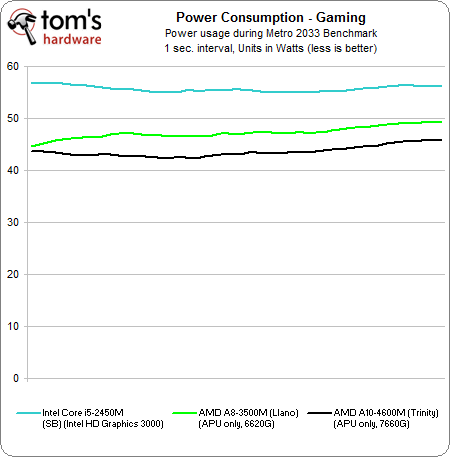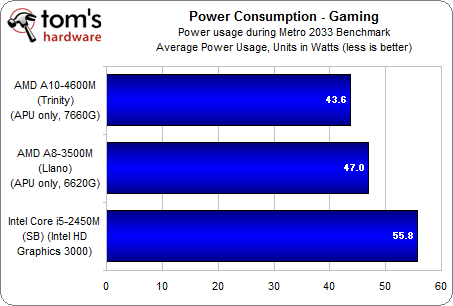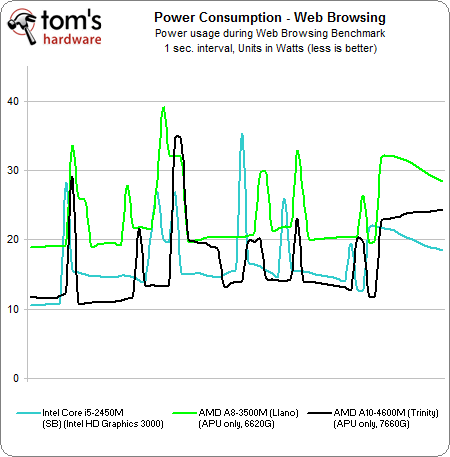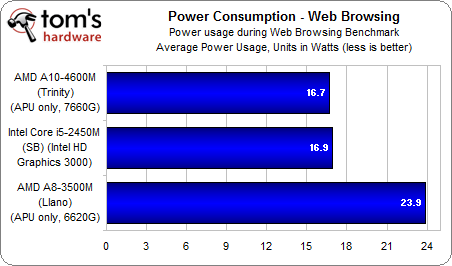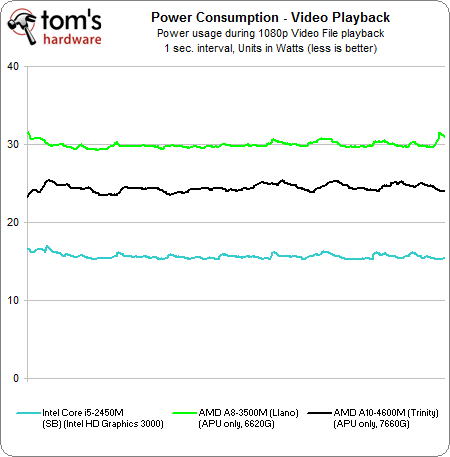AMD A10-4600M Review: Mobile Trinity Gets Tested
AMD steps up to the plate with an all-new processor. Armed with the updated Piledriver CPU core and VLIW4 graphics architecture, the Trinity APU represents an impressive improvement over the Llano generation. But can it stand up to Intel's best efforts?
Power Consumption
Llano fared particularly well in last year’s power metrics, so we’re quite interested to see how Trinity holds up, especially after all of AMD’s talk of minimizing unnecessary consumption. Although it’s true that the company’s newest APU doesn’t perform as well as Intel’s Core i5-2450M in our real-world productivity and content creation metrics, this can be forgiven to some extent on a mobile device able to last longer away from AC power.
We performed the following tests connected to an external monitor in order to factor out each notebook’s display as a variable. Power is measured at the plug with the battery removed.
This is probably the most impressive chart in today’s story. Despite the A10-4600M’s significant performance advantage in games, it manages do its job using a little less power than the A8-3500M and about 10 W less than Intel’s Core i5-2450M.
If you’re looking to play mainstream games on a mobile device, a Trinity-based APU is worth consideration.
Llano doesn’t do all that well in our Web-surfing benchmark. However, the Trinity-based APU and Intel’s Sandy Bridge-based Core i5 appear much better.
Moreover, both platforms seem to performance fairly similarly. See the last 10% of the benchmark, where the curves turn flat? This is where a YouTube video starts. The A10-4600M appears to use a little less power than Core i5-2450M when looking at webpages, but a little more when playing back streaming video. The A8-3500M uses more power in both workloads.
Our measure of playing back 1080p H.264-encoded video supports what we saw at the end of the Web-surfing benchmark, though we’re a little surprised. AMD claims that Trinity’s power usage is close to Sandy Bridge when playing back video. But these results show the APU using significantly more power (albeit less than Llano). We made sure that features like AMD Steady Video were disabled for this test, so we can’t blame the difference on real-time processing enhancements.
Get Tom's Hardware's best news and in-depth reviews, straight to your inbox.
Current page: Power Consumption
Prev Page APU Enhanced Software And The User Experience Next Page Tripling Your Pleasure With Trinity?Don Woligroski was a former senior hardware editor for Tom's Hardware. He has covered a wide range of PC hardware topics, including CPUs, GPUs, system building, and emerging technologies.
-
Recently Charlie at semiaccurate (a massive amd fanboy) hinting an upcoming apple products, then I saw an article in thg that tells an upcoming mbp will using retina display... 15 inch retina will require huge gpu horsepower, my wild guess is mbp will use trinity as it's CPU.Reply
-
Based on this, gaming is much better than old i5, but everything else including application performance is still better on the old Sandy architecture. I'm not really sure why I would buy a Trinity other than for a casual gaming laptop. Unfortunately, budget says that my laptops have to be used for business first, play time later.Reply
-
beenthere Nice to see that Trinity and AMD have delivered the goods. I want a Trinity powered Ultrathin. Intel can stick their crap where the Sun don't shine.Reply
BTW, Charlie @ SemiAccurate is not an AMD fanbois IME. He just calls it like it is. Reality bites sometimes be it Nvidia, AMD or Intel's problems. Denial never changes reality. It is what it is. -
cleeve duckwithnukesWhere is the Intel HD 4000 vs. AMD Trinity comparison? Lazy reviewing at its finest.Reply
A10-4600M laptops will be int eh $600-$700 neighborhood, and we're still waiting for Ivy bridge Core i5 to arrive in this price range.
We go over this. We also talk about how we'll do a follow up as soon as an appropriate product is available.
You need to read for it to make sense.
-
FlippyFlap, Apple doesn't use AMD and an HD4000 can power a retina display. I'm sure Apple has worked with Intel engineers to get the drivers right for retina displays which is HD4000's problem. HD4000 is still lacking in terms of driver support (one can see that from the OpenCL benches around the net where only 1/2 get acclerated on HD4000). When the drivers work right, there isn't much difference between Ivy and Trinity.Reply
-
I agree with Cleeve and I personally hate comparing a reference system to a selling system anyway. Review 2 actual selling systems with similar parts and that gives you the benchmark.Reply
-
DRosencraft This looks like a very nice effort from AMD. I really, really need to replace my notebook. It's a six year old Toshiba Satelite with an AMD 1.9 GHz Turion 64 X2 with intergrated X2100 graphics.... yeah. Ancient now, I know. I've been trying to figure out a sweet spot in power since my needs are kind of complex. Typically I don't need it to do much more than handle MSOffice and web surfing. But I also tend to use it for video gaming when am interesting game comes around and some work in PaintShop when I'm out of the house, or don't feel like sitting at my desktop. This may be a little closer to what I'd like. It would be nice to get a notebook that combines this with a really good discrete card (sort of like how some MacBook Pros have their dual graphics setup). Nevertheless, Trinity looks to be just about enough power and performance, but the question is price. If tradition holds, it should be a good price competitor with Intel, which is the most important part, otherwise I'd just buy a core I7 already.Reply
In a related question, does Trinity's details and specs lead to any conclusions about what Piledriver desktop processors will be like? -
neoverdugo So this means that AMD can kick Intel's ass in the gpu department for the moment while AMD suffers greatly in the CPU portion of the apu battle. Didn't I said before that Intel is trying to make an (proprietary) Intel only PC with no third party strings attached? We all know that there is no competition in the CPU battle when it comes to Intel. Still, i would like to see that the morons of intel to drop the price of their hardware for once and for all and drop ridiculously low end hardware out of production.Reply -
dgingeri No WoW benchmarks this time? I was wondering if this might make a good laptop for WoW, but you guys failed me. :(Reply
